Cookies that also provide fiber and protein! Our Low FODMAP High Protein Peanut Butter Banana Cookies feature unsweetened whey protein isolate protein powder, which is one of our favorite protein powders, because it is neutral in flavor, contains no carbohydrates or fat, and is versatile to use in recipes, such as this one. Isopure Zero Carb Protein powder is a great choice, featuring rBST-free whey, it is GMO free, contains no sugar, and is gluten and lactose free.
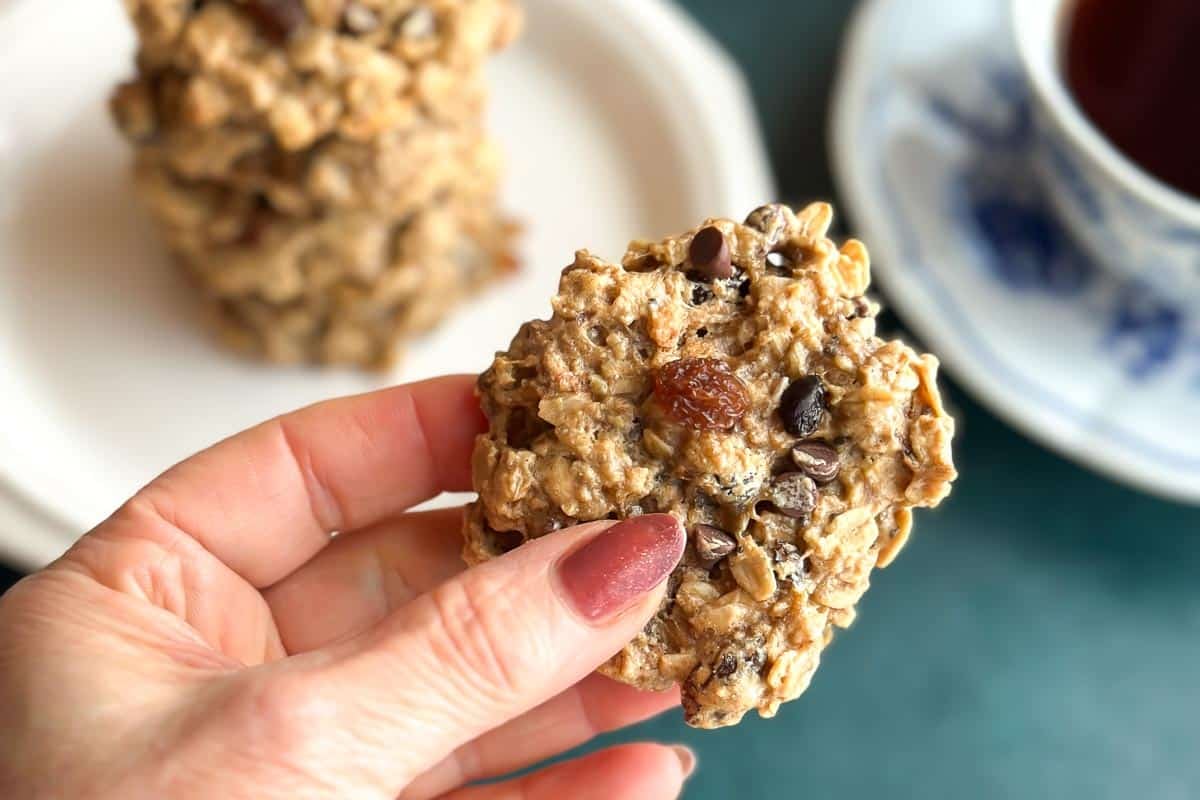
When we have a bag around, we think of new ways to use it all the time, as it incorporates into recipes so easily, from soups and chilis, to smoothies, cookies, energy balls, overnight oats, dips, dressings, and more.
The Low FODMAP Diet Includes Dairy
Let’s chat about dairy, lactose and foods that are lactose-free, as there is a lot of confusion when it comes to the low FODMAP diet. The low FODMAP diet is not dairy-free, nor is it lactose-free. It is lower in lactose.
Many cheeses are naturally lactose-free and low FODMAP, such as cheddar, mozzarella, Parmesan and more. They are common dairy ingredients that are naturally low FODMAP.

Isopure Zero Carb Protein powder is low FODMAP and lactose-free, even though it is dairy. When looking at whey products, look for “whey protein isolate”; this is low FODMAP. “Whey protein concentrate” is high FODMAP.
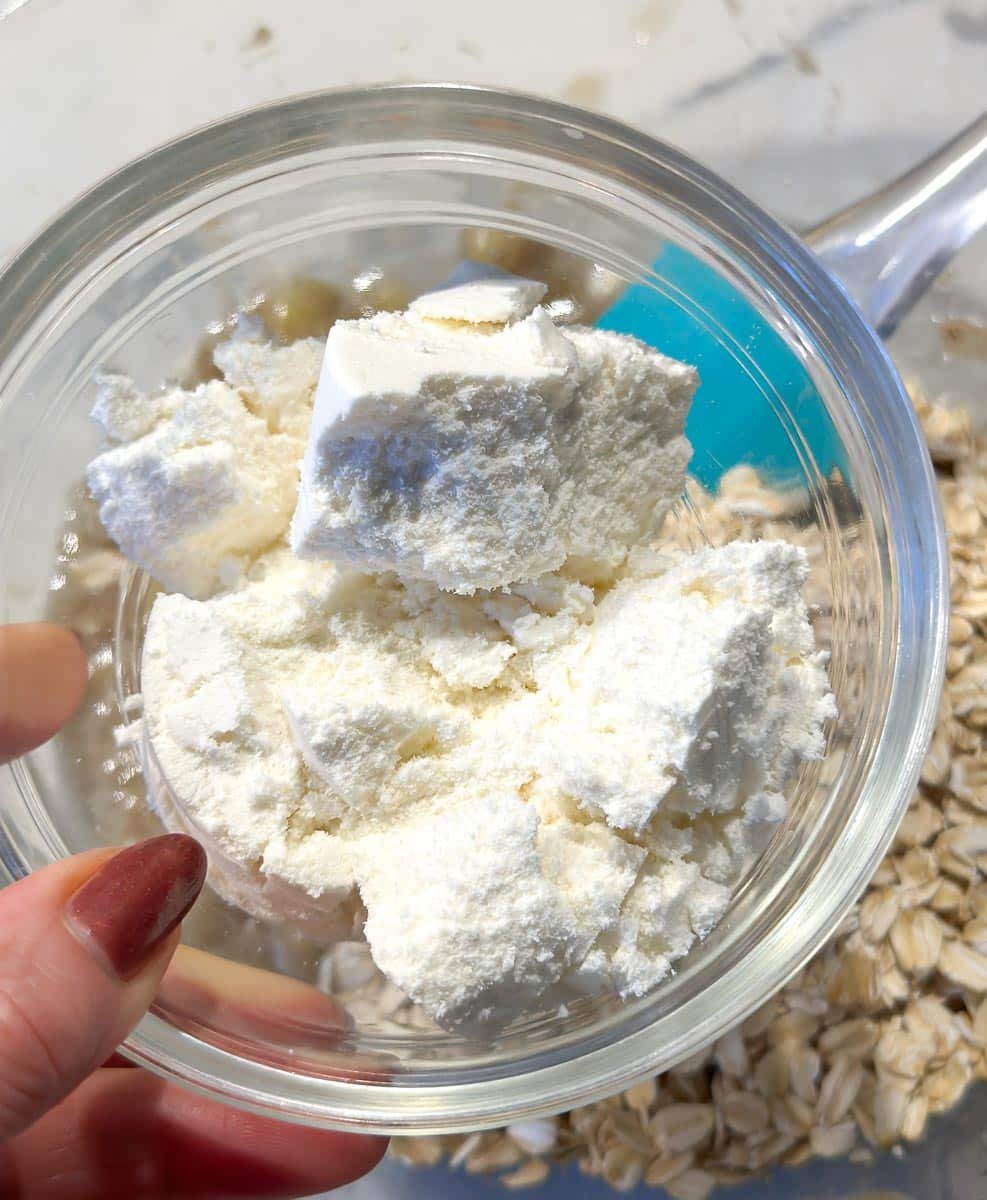
These Low FODMAP High Protein Peanut Butter Banana Cookies are suitable even for the Elimination Phase when consumed at the suggested serving size.
Are Bananas Low FODMAP?
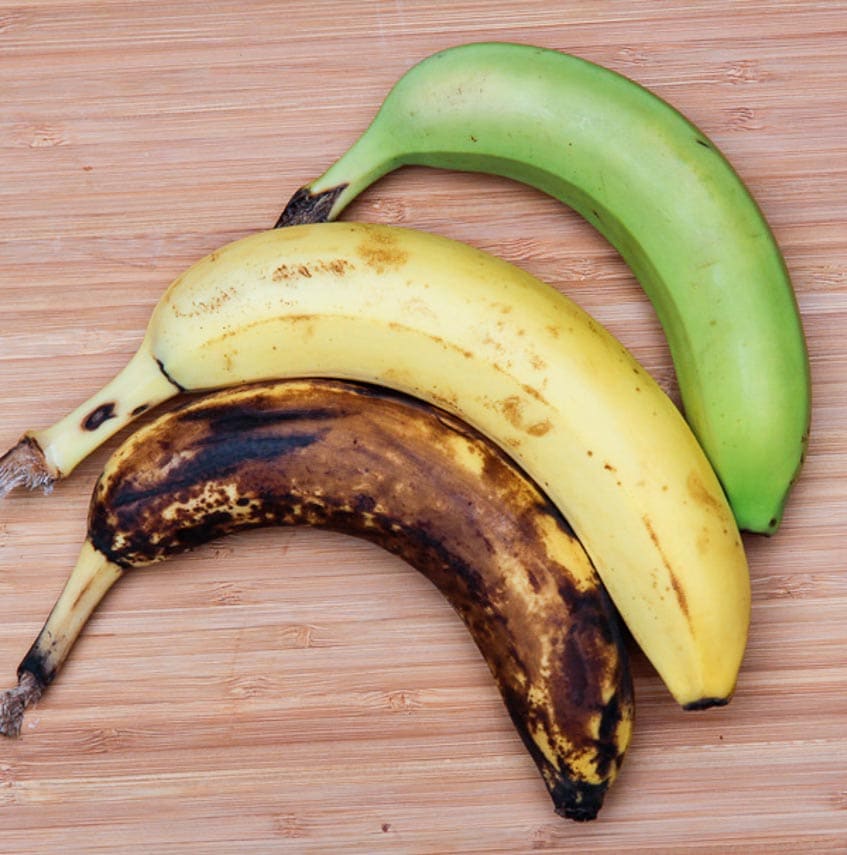
Yes, even ripe ones! Contrary to what you might have heard or read, there are low FODMAP servings of ripe banana. You can read more in our article, Are Bananas Low FODMAP? All the information in the article adheres to Monash University and FODMAP Friendly science.
PS: Whenever we can get a hold of ripe bananas, we peel some and freeze in a zip-top plastic bag. That way we can whip up recipes like this on the fly. I defrosted 2 frozen bananas in the microwave when I was preparing the cookies pictured.
Is Peanut Butter Low FODMAP?
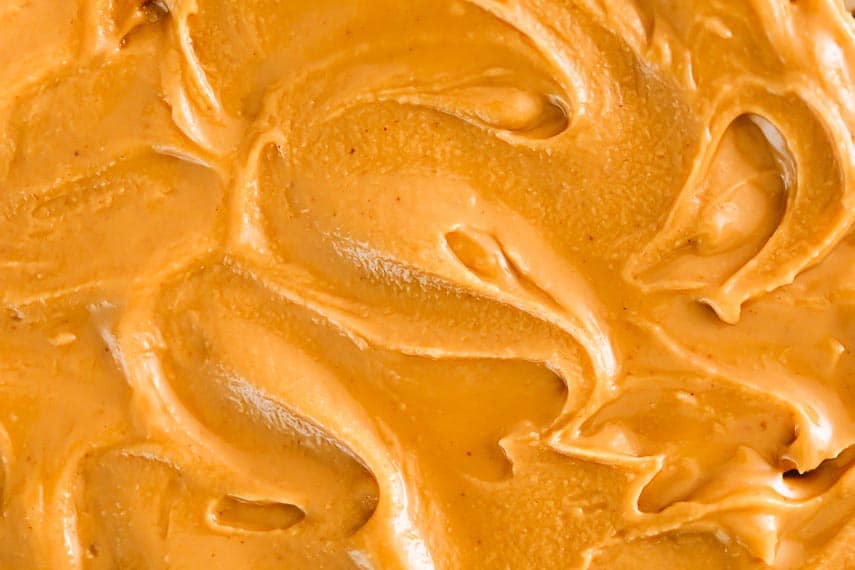
Yes, several kinds of peanut butter are low FODMAP! You can read more in our Explore An Ingredient: Peanut Butter. All the information in the article adheres to Monash University and FODMAP Friendly science.
Are Oats Low FODMAP?
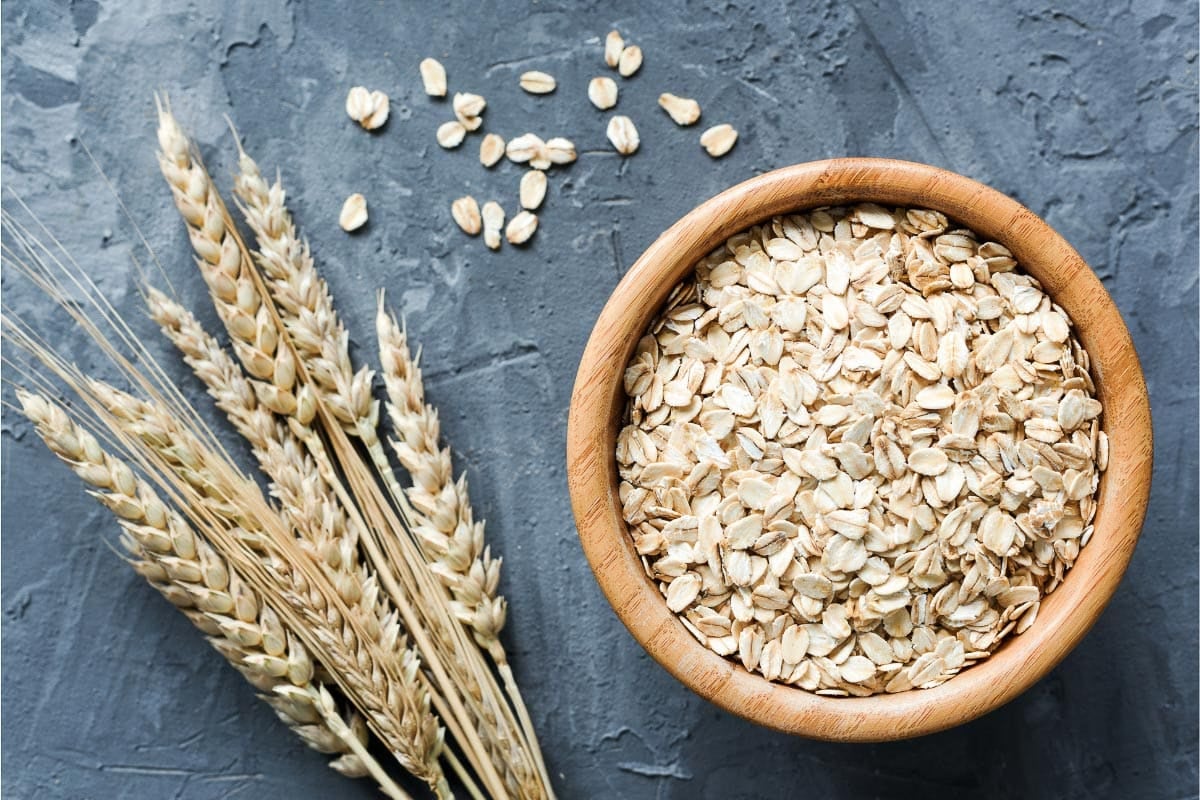
Many whole grains, such as oats, have low FODMAP servings. Rolled oats contain fiber, protein, vitamin C, calcium, and no cholesterol. They can be incorporated into your low FODMAP diet, even during the Elimination Phase. Check out our article, Explore An Ingredient: Oats & Oatmeal.
Is Maple Syrup Low FODMAP?
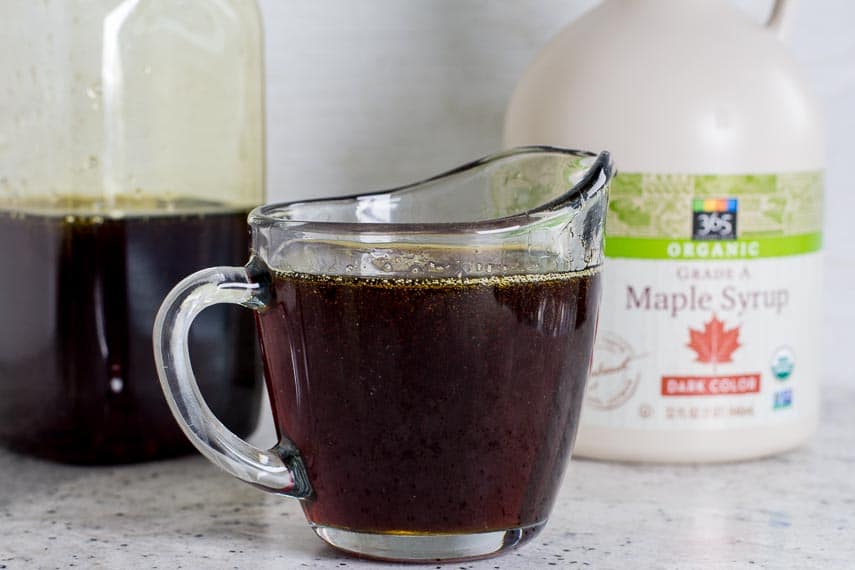
Not only is pure maple syrup low FODMAP, but it has also shown to contain no FODMAPs at all in lab testing! Make sure you buy pure maple syrup, and not “pancake syrup” or maple flavored syrups that are typically made with high fructose corn syrup, which is high FODMAP. Read more in our Explore An Ingredient: Maple Syrup.
Is Coconut Oil Low FODMAP?
All pure oils and fats contain no FODMAPs at all. Coconut oil, peanut oil, avocado oil, canola oil, vegetable oil, sunflower oil, corn oil are all FODMAP-free. Unrefined coconut oil tastes like coconut; refined does not. You can use either in this recipe. Read more in our article Is Coconut Low FODMAP?
We were inspired to create a low FODMAP version of these cookies.
Making Low FODMAP High Protein Peanut Butter Banana Cookies
Mash the bananas in a large mixing bowl until broken down into mush.
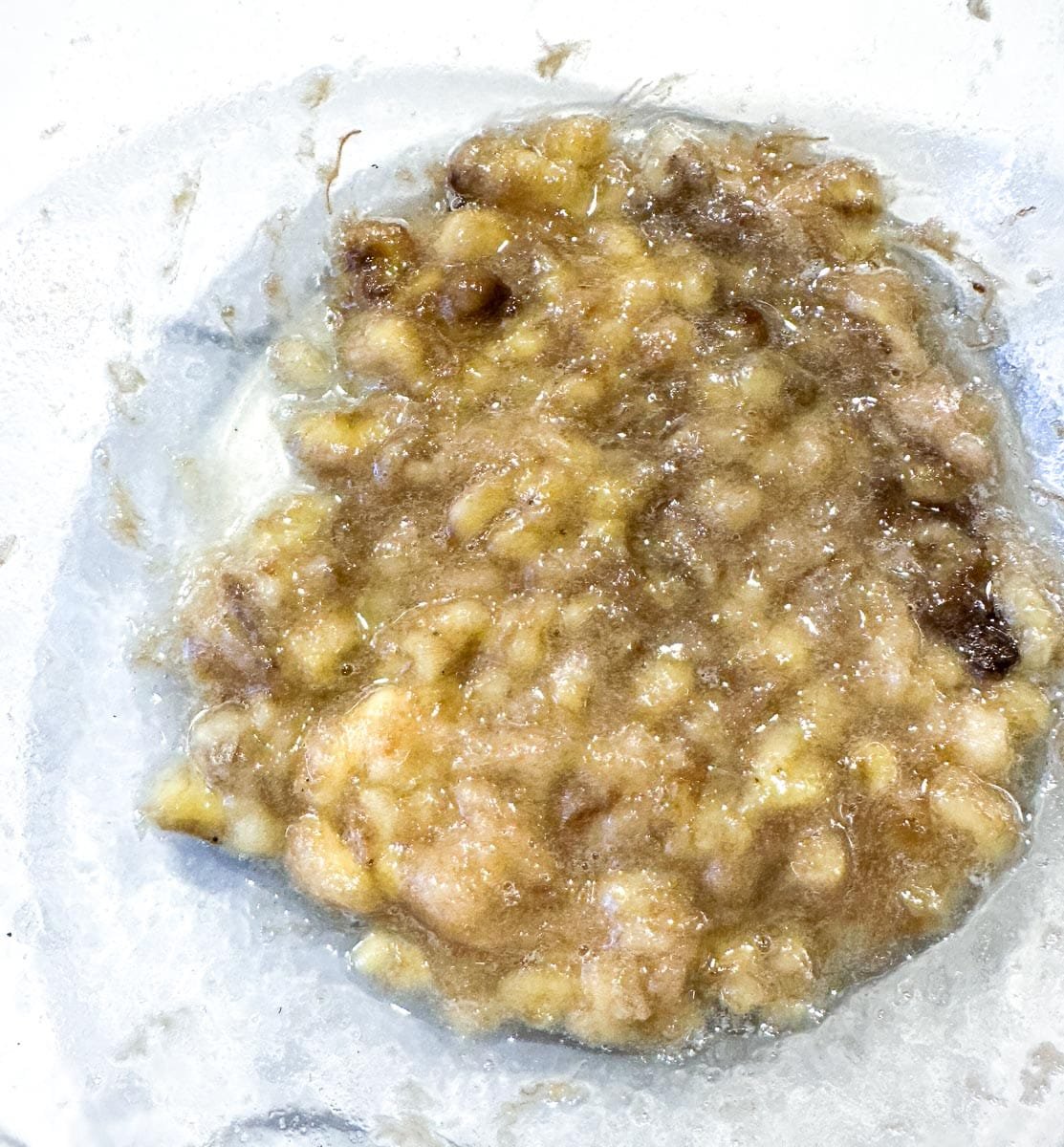
Add the oats, Isopure Zero Carb Protein powder, peanut butter, chocolate chips and raisins if using, the coconut oil, maple syrup, chia seeds if using, vanilla, cinnamon and salt.
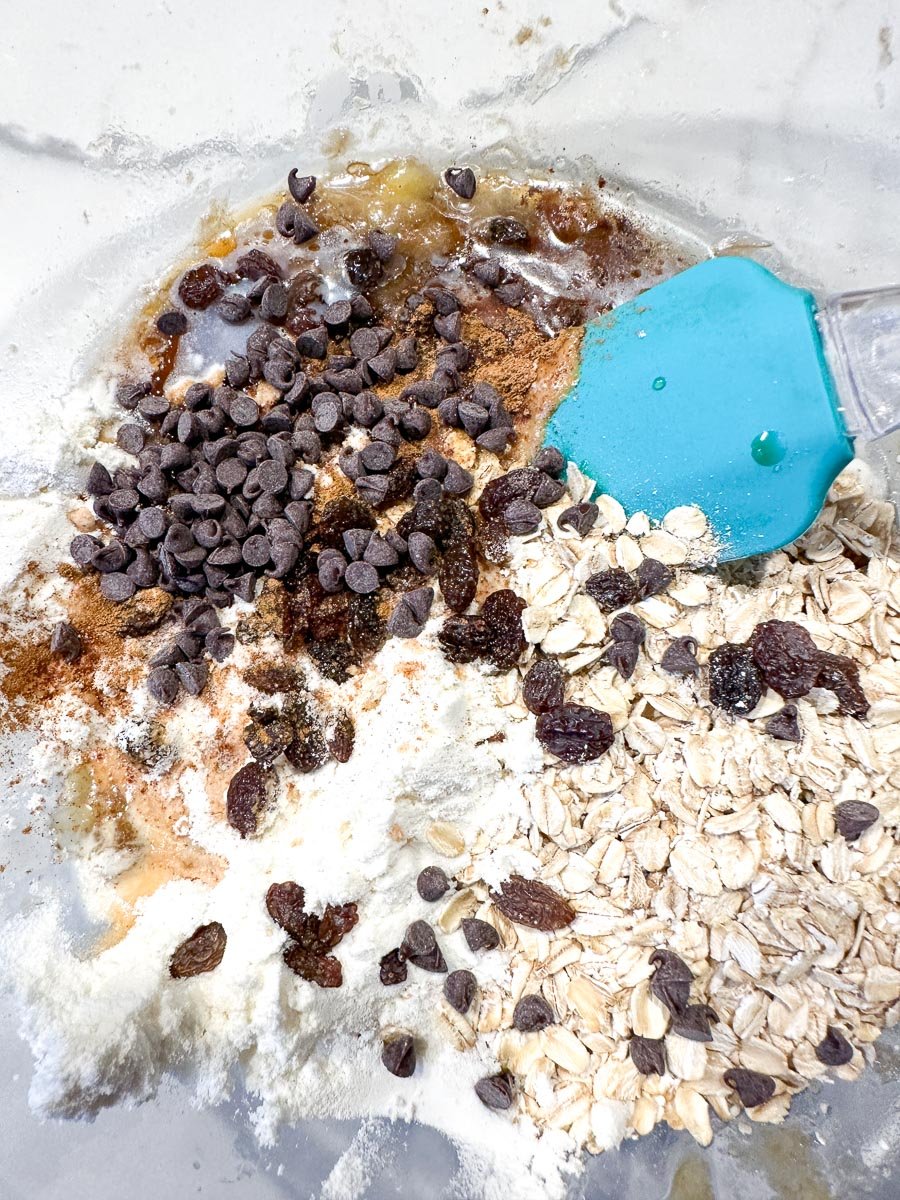
Stir together until well combined.
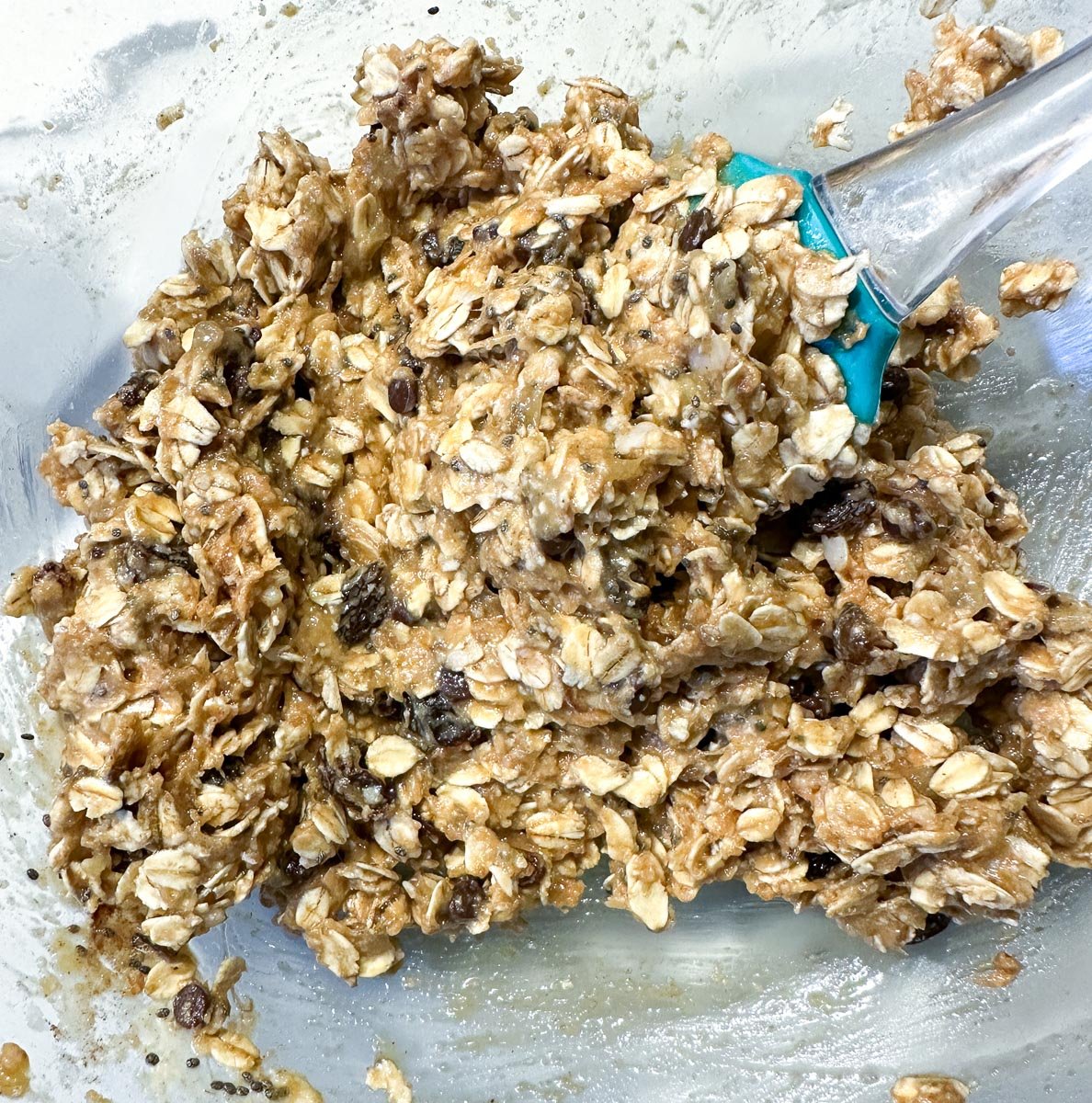
Dole out cookies (we use a scoop) to make 18 cookies (9 per pan).
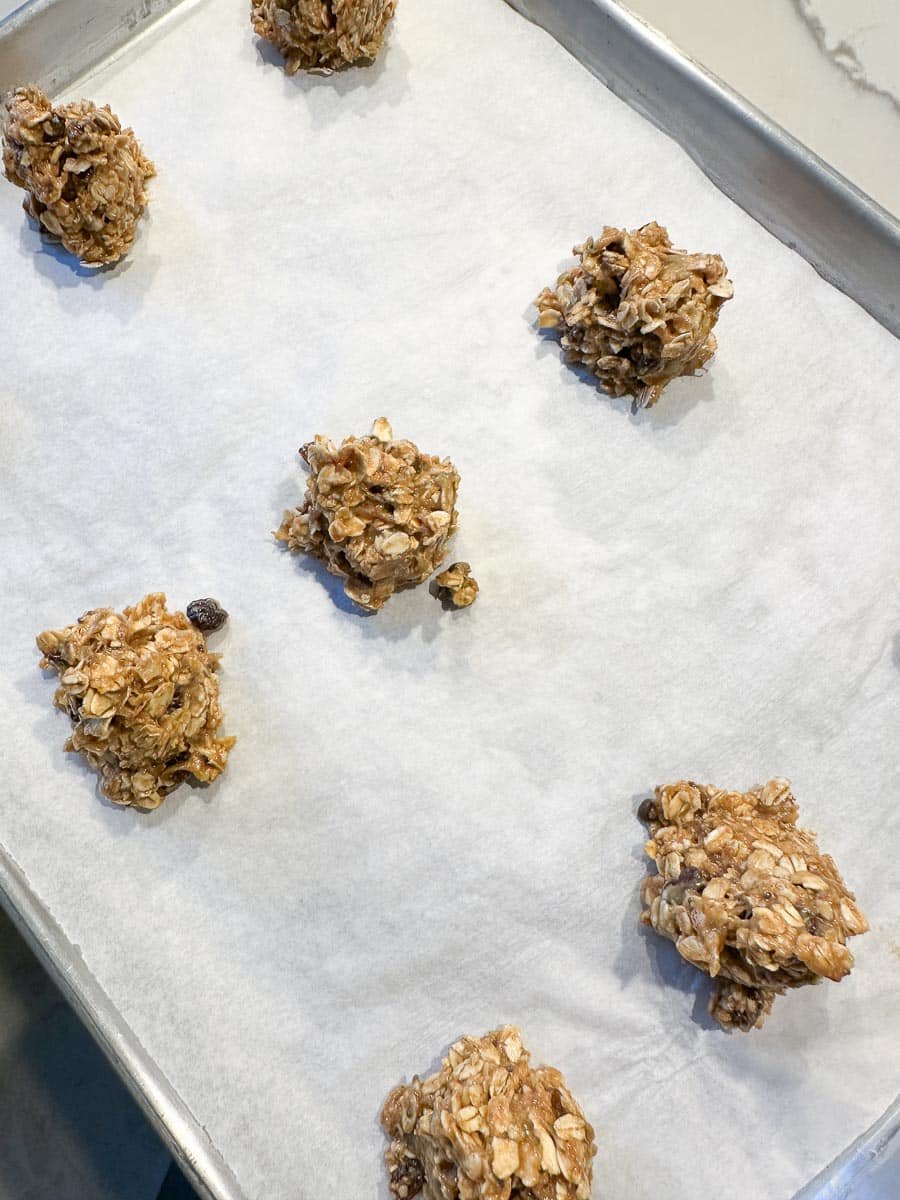
Flatten slightly, as they will not spread upon baking. I use dampened fingers to flatten them, but you can use the back of the scoop.
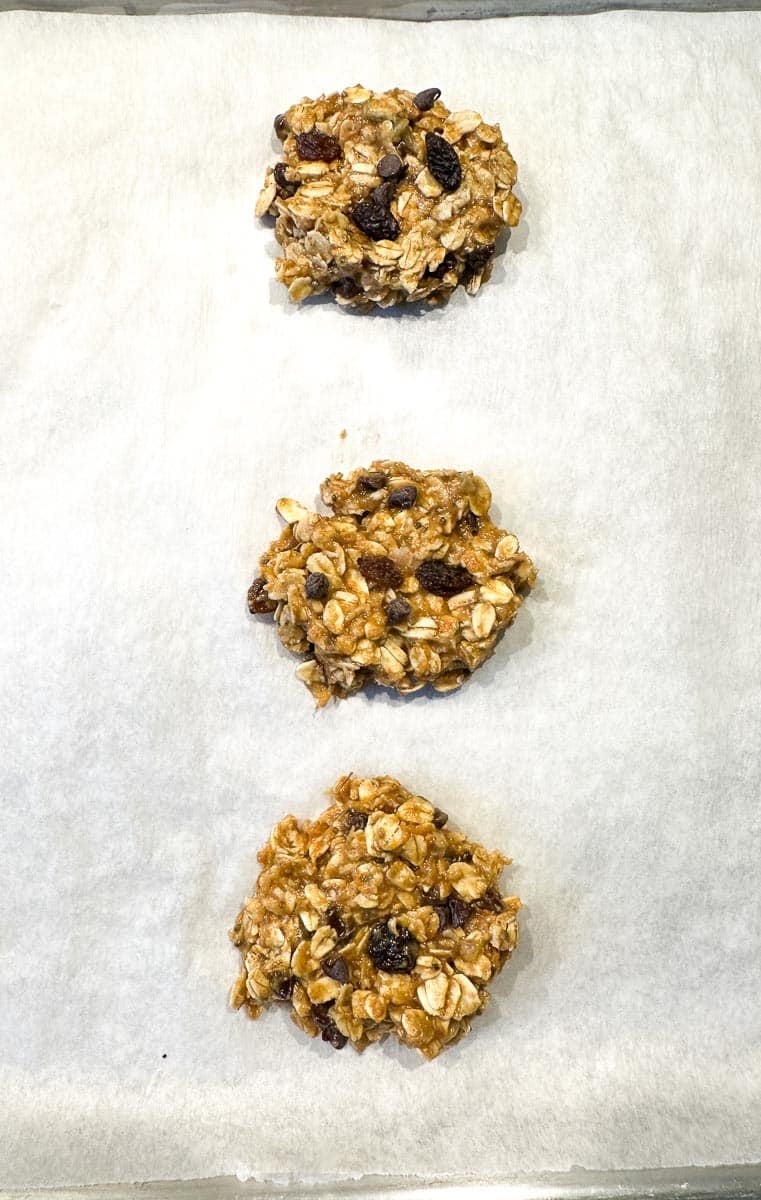
Bake for about 10 minutes or until just beginning to turn very light golden brown; just taking on color. The bottoms should be set enough for you to gently lift a cookie from the pan. Cool pans on racks. Store in an airtight container at room temperature for up to 4 days. They can be frozen for up to 1 month.
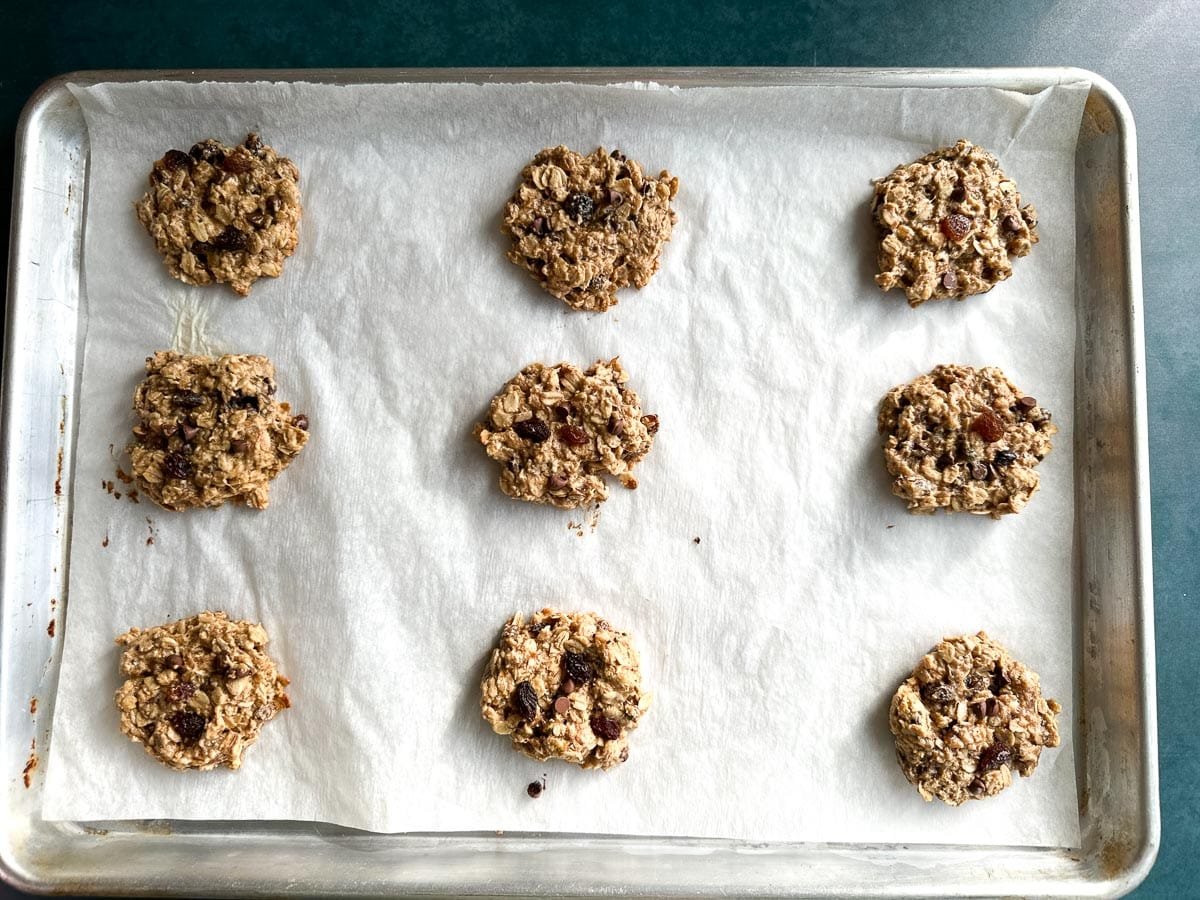
FODMAP Information
All recipes are based upon Monash University & FODMAP Friendly science at time of initial publication.
- Bananas: Bananas have both low and high FODMAP serving sizes. For the common banana, Monash University lab tests report that 1 medium firm banana of 95 g is low FODMAP, and that ⅓ of a medium ripe banana at 37 g is low FODMAP. The max serve for ripe bananas according to FODMAP Friendly lab tests is 88 g. Note that most baking recipes use very ripe bananas; our serving sizes reflect low FODMAP portions.
- Brown Sugar: Brown sugar has been lab tested by both Monash University and FODMAP Friendly. There are many kinds of brown sugar, from cane to beet (to blends) to Muscovado and more, which we discuss in our Explore An Ingredient: Sugar. Unfortunately, there is no information about what kind of brown sugars were lab tested. Monash gives us a low FODMAP amount of ¼ cup or 40 g but no further information. In addition, in private correspondence with Monash University we know that there are amounts larger than 40 g that would be considered low FODMAP. FODMAP Friendly gives us a low FODMAP amount of 13 g. Dark brown Muscovado sugar does appear in a product lab tested and certified low FODMAP by FODMAP Friendly, so we do know there is a low FODMAP amount.
- Chocolate: Monash University has lab tested dark, milk and white chocolate all have low FODMAP amounts: 85% dark at 20 g; dark at 30 g; milk at 20 g; white at 25 g. FODMAP Friendly has also lab tested dark chocolate, milk and white chocolate. Their lab tests place low FODMAP servings for dark chocolate at 30 g, with a max low FODMAP serving size of 102 g (that contains dairy). Milk chocolate is 30 g with a 42 g max serve; white chocolate is also 30 g with a max low FODMAP serve of 42 g.
- Maple Syrup: Both Monash University and FODMAP Friendly have lab tested maple syrup. Monash says that maple syrup is Green light and low FODMAP in servings of 2 Australian tablespoons (50 g). FODMAP Friendly gives it a “Pass” at 2 tablespoons (53 g). These amounts are recommended due to Australian healthy eating guidelines; no upper limit is posted by either Monash or FODMAP Friendly. Due to its chemical makeup, maple syrup contains more glucose than fructose and therefore can be considered free of FODMAPs. The FODMAP Friendly app does show you that no FODMAPs were detected in lab testing.
- Oats: Both Monash and FODMAP Friendly have lab tested oats. FODMAP Friendly gave rolled oats a “Pass” at ½ cup or 43 g servings; in an update to the app they report Quick Oats as low FODMAP at 47 g, or ½ cup uncooked. Their max low FODMAP serving is 59.53 g. Monash has several app entries and some are country specific. Here we present their “basic” app entries which are not country specific (use your app to look up the other entries). For their main entry called “rolled oats” they say a Green Light low FODMAP serving is ½ cup, which they peg at 52 g. For “quick oats” they state that a low FODMAP serving is only ¼ cup at 23 g, becoming moderate Yellow Light at ½ cup or 47 g.
- Oil: All pure oils are fats and contain no carbohydrates, therefore they contain no FODMAPs.
- Peanut Butter: Monash and FODMAP Friendly have both lab tested peanut butter. We have some information as to what kind of peanut butter was tested by Monash. They told us in private correspondence that the U.S. listing was representative of a combination of peanut butters: some made with hydrogenated oil and sugar, and some the no-stir style with palm oil and sugar (In other words, none of these are for natural peanut butter). They said the generic listing was most likely also from a combination of peanut butters, but gathered from a variety of countries, other than the U.S. (We find this to be ridiculous, as no one combines two types of peanut butters on a sandwich or in a recipe at the same time). They state that both (US and generic) are low FODMAP at 2 Australian tablespoons, although one is said to be 50 g and the other 32 g. FODMAP Friendly’s app image shows what looks to be some sort of creamy style (not natural). They give it a “Pass” at 2 tablespoons (50 g), but also state a Max Serve at 6.86 ounces or 192.05 g. It is also important to note that Monash has said peanuts themselves have only trace amounts of FODMAPs and they say that peanut butter only becomes Moderate for fructose at 140 g. If you malabsorb fructose, it might be an issue; for others it might be tolerated very well.
- Raisins: Monash and FODMAP Friendly have both lab tested raisins. While raw grapes contain no FODMAPs, the natural sugars concentrate upon drying and the resulting raisins do contain FODMAPs. Monash says a low FODMAP Green Light serving is 1 Australian tablespoon (13 g). FODMAP Friendly gives them a “Pass” at 3 tablespoons (30 g); they set a max serve at 13 tablespoons (130 g).
- Sugar: Monash University and FODMAP Friendly have both lab tested white, granulated sugar. Monash states that a Green Light low FODMAP serving size of white sugar is ¼ cup (50 g). FODMAP Friendly simply states that they have tested 1 tablespoon and that it is low FODMAP. Regular granulated white sugar is sucrose, which is a disaccharide made up of equal parts glucose and fructose. Sucrose is broken down and absorbed efficiently in the small intestine. As the fructose is never in excess of the glucose, white sugar will never be high FODMAP, even in large amounts.
Please always refer to the Monash University & FODMAP Friendly smartphone apps for the most up-to-date lab tested information. Foods will be retested from time to time; in the case of raw ingredients, such as fruits and vegetables, results may vary. All lab tested results are valid and represent a snapshot in time. As always, your tolerance is what counts; please eat accordingly. The ultimate goal of the low FODMAP diet is to eat as broadly as possible, without triggering symptoms, for the healthiest microbiome.
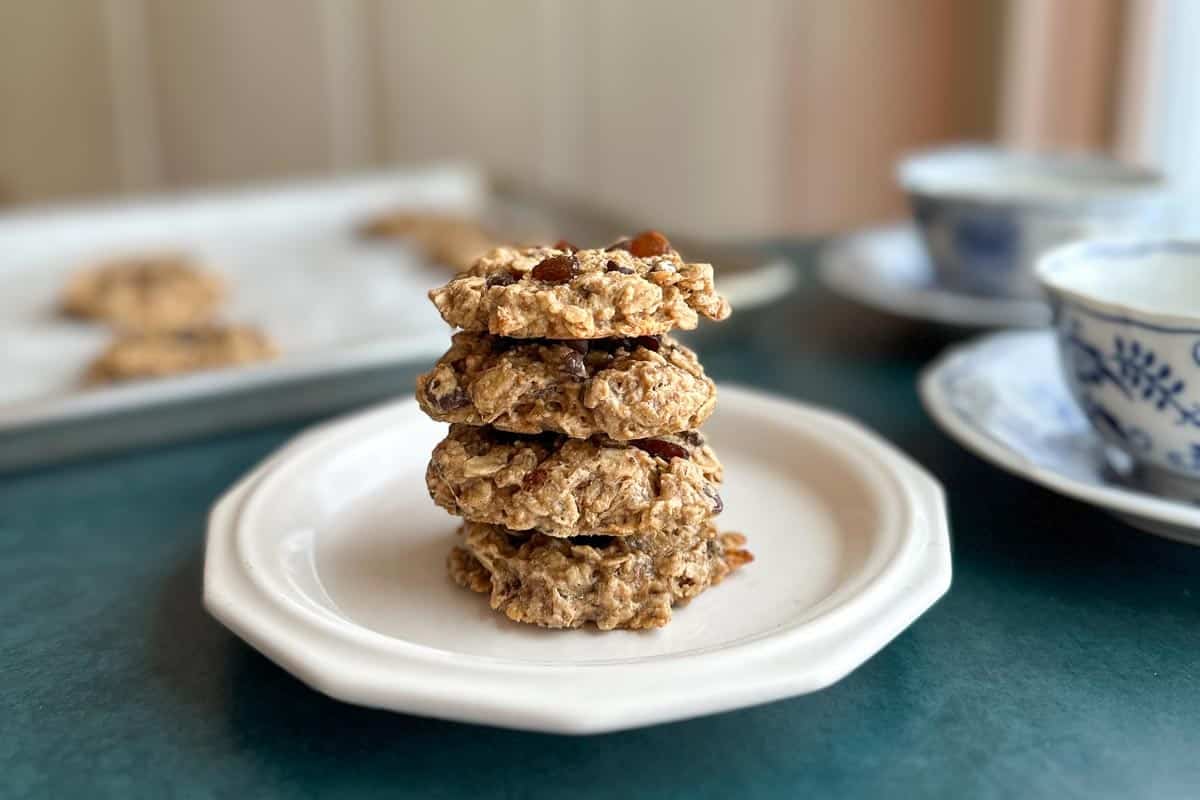

Low FODMAP High Protein Peanut Butter Banana Cookies
Cookies that also provide fiber and protein! Our Low FODMAP High Protein Peanut Butter Banana Cookies feature unsweetened whey protein isolate protein powder, which is one of our favorite protein powders, because it is neutral in flavor, contains no carbohydrates or fat, and is versatile to use in recipes, such as this one. Isopure Zero Carb Protein powder is a great choice, featuring rBST whey, it is GMO free, contains no sugar and is gluten and lactose free. When we have a bag around, we think of new ways to use it all the time, as it incorporates into recipes so easily, from soups and chilis, to smoothies, cookies, energy balls, overnight oats, dips, dressings, and more.
Low FODMAP Serving Size Information: Makes 18 cookies; 1 cookie per serving; 18 servings.
Ingredients:
- 2 medium-sized ripe bananas
- 2 cups (198 g) rolled oats, use gluten-free if following a gluten-free diet
- 2 scoops (58 g) unsweetened whey protein isolate powder, such as Isopure Zero Carb Protein powder
- ⅓ cup (85 g) natural creamy peanut butter
- ¼ cup (56 g) semisweet chocolate chips, miniature or regular size, optional
- ¼ cup (42 g) dark raisins, optional
- 2 tablespoons refined or unrefined coconut oil, melted
- 2 tablespoons maple syrup
- 1 tablespoon chia seeds, optional
- 1 teaspoon vanilla extract
- ½ teaspoon ground cinnamon
- ¼ teaspoon salt
Preparation:
-
Preheat oven to 325°F (165°C). Line two half-sheet pans with parchment paper.
-
Mash the bananas in a large mixing bowl until broken down into mush. Stir in the oats, Isopure Zero Carb Protein powder, peanut butter, chocolate chips and raisins if using, the coconut oil, maple syrup, chia seeds if using, vanilla, cinnamon and salt until well combined.
-
Dole out cookies (we use a scoop) to make 18 cookies (9 per pan), and flatten slightly, as they will not spread upon baking. I use dampened fingers to flatten them, but you can use the back of the scoop.
-
Bake for about 10 minutes or until just beginning to turn very light golden brown; just taking on color. The bottoms should be set enough for you to gently lift a cookie from the pan. Cool pans on racks. Store in an airtight container at room temperature for up to 4 days. They can be frozen for up to 1 month.
Notes:
FODMAP Information
All recipes are based upon Monash University & FODMAP Friendly science at time of initial publication.
• Bananas: Bananas have both low and high FODMAP serving sizes. For the common banana, Monash University lab tests report that 1 medium firm banana of 95 g is low FODMAP, and that ⅓ of a medium ripe banana at 37 g is low FODMAP. The max serve for ripe bananas according to FODMAP Friendly lab tests is 88 g. Note that most baking recipes use very ripe bananas; our serving sizes reflect low FODMAP portions.
• Brown Sugar: Brown sugar has been lab tested by both Monash University and FODMAP Friendly. There are many kinds of brown sugar, from cane to beet (to blends) to Muscovado and more, which we discuss in our Explore An Ingredient: Sugar. Unfortunately, there is no information about what kind of brown sugars were lab tested. Monash gives us a low FODMAP amount of ¼ cup or 40 g but no further information. In addition, in private correspondence with Monash University we know that there are amounts larger than 40 g that would be considered low FODMAP. FODMAP Friendly gives us a low FODMAP amount of 13 g. Dark brown Muscovado sugar does appear in a product lab tested and certified low FODMAP by FODMAP Friendly, so we do know there is a low FODMAP amount.
• Chocolate: Monash University has lab tested dark, milk and white chocolate all have low FODMAP amounts: 85% dark at 20 g; dark at 30 g; milk at 20 g; white at 25 g. FODMAP Friendly has also lab tested dark chocolate, milk and white chocolate. Their lab tests place low FODMAP servings for dark chocolate at 30 g, with a max low FODMAP serving size of 102 g (that contains dairy). Milk chocolate is 30 g with a 42 g max serve; white chocolate is also 30 g with a max low FODMAP serve of 42 g.
• Maple Syrup: Both Monash University and FODMAP Friendly have lab tested maple syrup. Monash says that maple syrup is Green light and low FODMAP in servings of 2 Australian tablespoons (50 g). FODMAP Friendly gives it a “Pass” at 2 tablespoons (53 g). These amounts are recommended due to Australian healthy eating guidelines; no upper limit is posted by either Monash or FODMAP Friendly. Due to its chemical makeup, maple syrup contains more glucose than fructose and therefore can be considered free of FODMAPs. The FODMAP Friendly app does show you that no FODMAPs were detected in lab testing.
• Oats: Both Monash and FODMAP Friendly have lab tested oats. FODMAP Friendly gave rolled oats a “Pass” at ½ cup or 43 g servings; in an update to the app they report Quick Oats as low FODMAP at 47 g, or ½ cup uncooked. Their max low FODMAP serving is 59.53 g. Monash has several app entries and some are country specific. Here we present their “basic” app entries which are not country specific (use your app to look up the other entries). For their main entry called “rolled oats” they say a Green Light low FODMAP serving is ½ cup, which they peg at 52 g. For “quick oats” they state that a low FODMAP serving is only ¼ cup at 23 g, becoming moderate Yellow Light at ½ cup or 47 g.
• Oil: All pure oils are fats and contain no carbohydrates, therefore they contain no FODMAPs.
• Peanut Butter: Monash and FODMAP Friendly have both lab tested peanut butter. We have some information as to what kind of peanut butter was tested by Monash. They told us in private correspondence that the U.S. listing was representative of a combination of peanut butters: some made with hydrogenated oil and sugar, and some the no-stir style with palm oil and sugar (In other words, none of these are for natural peanut butter). They said the generic listing was most likely also from a combination of peanut butters, but gathered from a variety of countries, other than the U.S. (We find this to be ridiculous, as no one combines two types of peanut butters on a sandwich or in a recipe at the same time). They state that both (US and generic) are low FODMAP at 2 Australian tablespoons, although one is said to be 50 g and the other 32 g. FODMAP Friendly’s app image shows what looks to be some sort of creamy style (not natural). They give it a “Pass” at 2 tablespoons (50 g), but also state a Max Serve at 6.86 ounces or 192.05 g. It is also important to note that Monash has said peanuts themselves have only trace amounts of FODMAPs and they say that peanut butter only becomes Moderate for fructose at 140 g. If you malabsorb fructose, it might be an issue; for others it might be tolerated very well.
• Raisins: Monash and FODMAP Friendly have both lab tested raisins. While raw grapes contain no FODMAPs, the natural sugars concentrate upon drying and the resulting raisins do contain FODMAPs. Monash says a low FODMAP Green Light serving is 1 Australian tablespoon (13 g). FODMAP Friendly gives them a “Pass” at 3 tablespoons (30 g); they set a max serve at 13 tablespoons (130 g).
• Sugar: Monash University and FODMAP Friendly have both lab tested white, granulated sugar. Monash states that a Green Light low FODMAP serving size of white sugar is ¼ cup (50 g). FODMAP Friendly simply states that they have tested 1 tablespoon and that it is low FODMAP. Regular granulated white sugar is sucrose, which is a disaccharide made up of equal parts glucose and fructose. Sucrose is broken down and absorbed efficiently in the small intestine. As the fructose is never in excess of the glucose, white sugar will never be high FODMAP, even in large amounts.
Please always refer to the Monash University & FODMAP Friendly smartphone apps for the most up-to-date lab tested information. Foods will be retested from time to time; in the case of raw ingredients, such as fruits and vegetables, results may vary. All lab tested results are valid and represent a snapshot in time. As always, your tolerance is what counts; please eat accordingly. The ultimate goal of the low FODMAP diet is to eat as broadly as possible, without triggering symptoms, for the healthiest microbiome.
Nutrition
All nutritional information is based on third-party calculations and should be considered estimates. Actual nutritional content will vary with brands used, measuring methods, portion sizes and more. For a more detailed explanation, please read our article Understanding The Nutrition Panel Within Our Recipes.
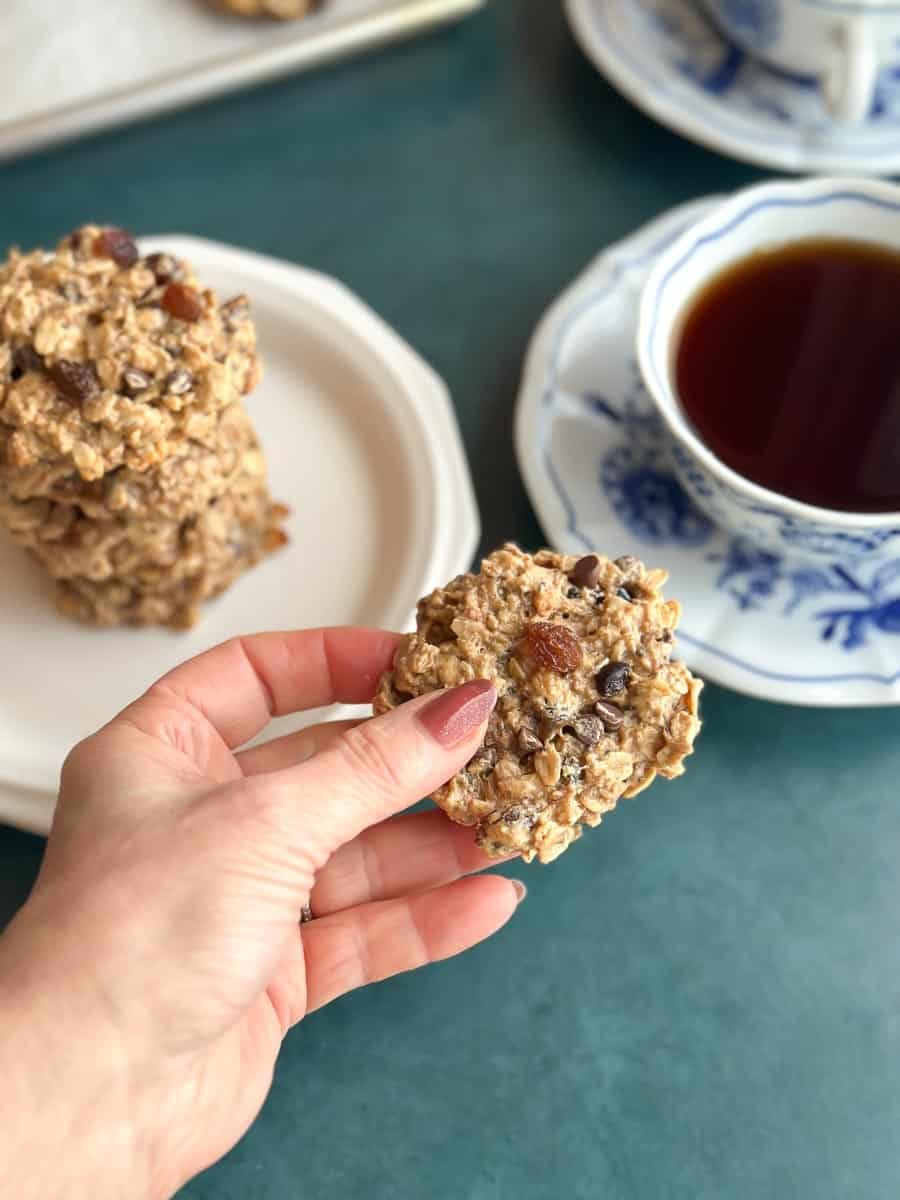
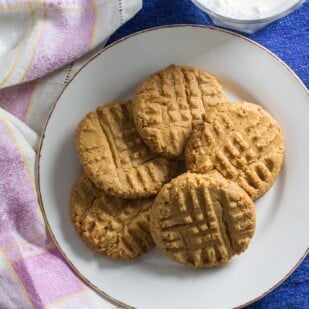
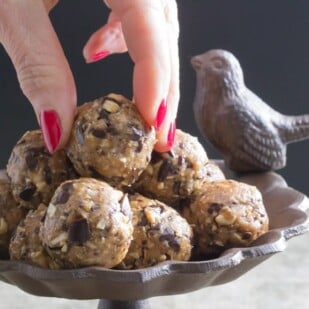





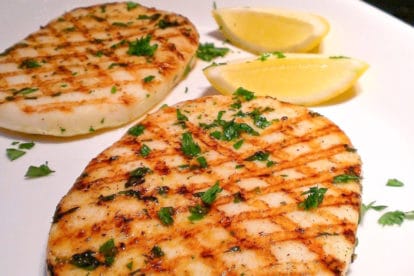
We love working whey protein isolate powder into recipes to boost protein! Unsweetened, unflavored is our favorite and is the most versatile. Isopure has a great one.